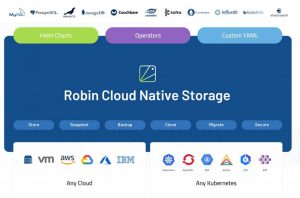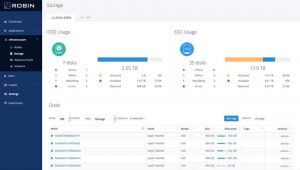Robin.io Embraces IBM Cloud Satellite With Container-Native Storage and Data Management Capabilities
Cloud native storage takes application-focused approach to Kubernetes storage and data management.
This is a Press Release edited by StorageNewsletter.com on March 9, 2021 at 2:32 pmRobin.io announced that its solution for Kubernetes storage can run on IBM Cloud Satellite, to help enterprises manage their applications across multiple environments.
Click to enlarge
Cloud Satellite, available, enables clients to run IBM Cloud services in multiple environments-on IBM Cloud, on premises, or at the edge-all delivered as a service. This flexibility will help bring cloud capabilities to where client data resides, in the environment of their choice, while focusing on consistency, user experience, and security.
The company is part of IBM Corp.‘s ecosystem of partners fueling hybrid cloud environments by helping clients manage and modernize workloads from bare-metal to multicloud and everything in between with Red Hat OpenShift, the enterprise Kubernetes platform. Cloud Satellite is engineered to give clients the flexibility to bring their applications to environments where their data resides while leveraging the security of IBM Cloud. [1]
There can be many benefits to having multiple cloud environments, provided companies can overcome inconsistency, complexity, and a shortage of skills and time required to operate and secure these rapidly evolving platforms. These cloud architectures are further complicated by the different development practices each environment requires.
The Robin Cloud Native Storage solution will be available on IBM Cloud Pak for Data and as a standalone product on Red Hat Marketplace. An OpenShift Certified Operator, the company’s Cloud Native Storage is verified by Red Hat as a supported enterprise application that works across hybrid and multi-cloud environments.
Click to enlarge
“Robin Cloud-Native Storage (CNS) is designed to bring advanced data management capabilities to Kubernetes, whether deployed on-premises or in any public cloud,” said Partha Seetala, founder and CEO, Robin.io. “Robin CNS also offers application-consistent seamless mobility for workloads between clouds and on-premises clusters. Robin CNS coupled with IBM Cloud Satellite can help customers gain the flexibility to run, protect and move their applications to the infrastructures best suited to their business needs while still leveraging the security and operations benefits of the public cloud. Satellite locations can be in on-premises data centers, colocation centers or even at an Edge deployment.“
“With the pace of cloud adoption accelerating, companies are increasingly turning to hybrid cloud to allow them to innovate more efficiently, while maintaining high levels of security and control,” said Harish Grama, GM, IBM Cloud. “To help facilitate this momentum, IBM is investing $1 billion in its ecosystem initiative over the next 3 years to support ecosystem partners and speed the development of platforms such as IBM Cloud Satellite. Collaborating with ecosystem partners like Robin.io can help offer a wider set of clients new ways of bringing IBM Cloud to where their data resides.“
About IBM Cloud Satellite
With its open architecture, it builds on IBM‘s expertise and can help enterprises across industries including telecommunications, healthcare, banking, insurance, travel and transportation, transform into digital-first organizations. The need to modernize mission-critical workloads is intensifying. According to a recent IBM Institute for Business Value report, 74% of CEOs interviewed during the Covid-19 pandemic believe cloud computing will most help their organization deliver these results over the next 2-3 years. There is a cornerstone of this transformation is in edge computing. The continued proliferation of edge devices is expected to shift the amount of data that resides at the edge compared to within central data centers. As this transition takes place, Cloud Satellite is designed to bring cloud services to where clients’ data already resides-and help them bridge to where they want to go.
It is designed to help clients address security, privacy and data sovereignty requirements based on their data governance requirements and address the client’s local regulations and compliance obligations by enabling them to deploy and manage applications with consistency for specific markets. It offers high levels of control over critical data delivered via IBM Cloud – a secure and open public cloud for business.[1] Moreover, it offers high levels of control over critical data and centralized policies to ease migration. Those cloud services can therefore be co-located with their apps and data, helping to reduce latency and taking regulatory considerations into account.
[1]Based on IBM Hyper Protect Crypto Service, the only public-cloud enabled FIPS 140-2 Level 4-certified Hardware Security Module (HSM). FIPS 140-2 Security Level 4 provides the highest level of security defined in this standard. At this security level, the physical security mechanisms provide a comprehensive envelope of protection around the cryptographic module with the intent of detecting and responding to all unauthorized attempts at physical access.















 Subscribe to our free daily newsletter
Subscribe to our free daily newsletter

